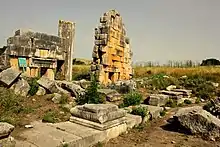Kedesh
The ruins of the ancient Canaanite city of Kedesh (alternate spellings: Cadesh, Cydessa) are located 3 km northeast of the modern Kibbutz Malkiya in Israel on the Israeli-Lebanese border.[1]
 Tel Kedesh | |
 Shown within Israel | |
| Alternative name | Cydessa |
|---|---|
| Location | Northern District, Israel |
| Region | Upper Galilee |
| Coordinates | 33.111638°N 35.529517°E |
| Type | Settlement |
| Site notes | |
| Condition | In ruins |
History
Kedesh was first documented in the Book of Joshua as a Canaanite citadel conquered by the Israelites under the leadership of Joshua. Ownership of Kedesh was turned over by lot to the tribe of Naphtali and subsequently, at the command of God, Kedesh was set apart by Joshua as a Levitical city and one of the Cities of Refuge along with Shechem and Kiriath Arba (Hebron) (Joshua 20:7).
In the 8th century BCE, during the reign of Pekah king of Israel, Tiglath-Pileser III of Assyria took Kedesh and deported its inhabitants to Assyria. (2 Kings 15:29)
Later, during the 5th century BCE, Kedesh may have become the capital for the Persian-controlled and Tyrian-administrated province of the Upper Galilee.[2]
In 259 BCE Kedesh was mentioned by Zenon, a traveling merchant from Egypt.[3]
Between 145 BCE and 143 BCE, Kedesh (Cades) was overthrown by Jonathan Maccabeus in his fight against Seleucid king Demetrius II Nicator.[4][5] It remains abandoned. From 1997 to 2012, Tel Kedesh was excavated by a team from the University of Michigan's Kelsey Museum of Archaeology in conjunction with the University of Minnesota,[6] focusing in 2010 and 2012 on the Persian and Hellenistic Administrative Building.
According to Jewish tradition, Deborah the prophetess, Barak the son of Abinoam and Jael, the wife of Heber the Kenite, as also Heber, were buried near the spring beneath the town of Kedesh.[7]
Eusebius, writing about the place in his Onomasticon, says: "Kedesh. A priestly city in the inheritance of Naphtali. Previously it was a city of refuge 'in Galilee in the hill country of Naphtali.' The 'king of the Assyrians' destroyed it (2 Kings 15:29). This is (now) Kydissos (Κυδισσός), twenty miles from Tyre near Paneas."[8]
Kedesh of Naphtali
Identification of the biblical "Kedesh of Naphtali" (Judges 4:6, 10) has been the subject of archaeological and historical debate. While many hold the ancient site to be in Upper Galilee, near the Lebanese border, Israeli archaeologist, Yohanan Aharoni, held the view that it lay in Lower Galilee, near the Valley of Jezreel, at a site which bears the same name (now Khirbet Qadish).[9] Some prominent archaeological publications have, therefore, listed the site as being east of the "Jabneel valley" in "Lower Galilee."[10]
From 1997–2010, archaeological excavations were conducted at the Kedesh-Naphtali (Qadesh) site by Herbert Sharon and Andrea Berlin on behalf of the University of Michigan.[11][12]
Middle Ages
Ishtori Haparchi, visiting the holy sites in the early fourteenth-century wrote of Kedesh: "About half a day's distance southward of Paneas, known in Arabic as Banias, is Kedesh, in the mountain of Naphtali, and it is [now] called Qades."[13]
Other
In the Book of Judges, the great oak tree in Zaanaim is stated to be near Kedesh, though this verse could be a reference to a second Tel Kedesh, located 3 km to the south of Megiddo, within the territory of the Israelite tribe of Issachar. (Judges 4:11)
See also
References
- Negev and Gibson, 2005, p. 278.
- Berlin, Andrea and Herbert, Sharon (2005). "Life and Death on the Israel-Lebanon Border". Biblical Archaeology Review 31 (5), 34-43.
- Papyrus Cairo Zenon I 59.004
- 1 Maccabees 11:63-74 (text)
- Antiquities of the Jews 13.154-62; The Wars of the Jews 2.459, 4.104.
- "Tel Kedesh, Israel". Archived from the original on July 20, 2012.
- Burial Places of the Fathers, published by Yehuda Levi Nahum in book: Ṣohar la-ḥasifat ginzei teiman (Heb. צהר לחשיפת גנזי תימן), Tel-Aviv 1986, p. 248
- Eusebius, Onomasticon - The Place Names of Divine Scripture, (ed.) R. Steven Notley & Ze'ev Safrai, Brill: Leiden 2005, pp. 111–112 (§601), note 601 ISBN 0-391-04217-3
- Meyers, E.M., Strange, J.F., and Groh, D.E., "The Meiron Excavation Project: Archaeological Survey in Galilee and Golan, 1976," in: Bulletin of the American Schools of Oriental Research (No. 230 - April 1978), p. 4, citing Aharoni, Y. (1976) "Upper Galilee," in vol. 2 of Encyclopedia of Archaeological Excavations in the Holy Land (ed. M. Avi-Yonah), Israel Exploration Society: Jerusalem.
- Archaeological Encyclopedia of the Holy Land (ed. Avraham Negev & Shimon Gibson), New York 2001, p. 278 (s.v. Kedesh-Naphtali) ISBN 0-8264-1316-1
- Israel Antiquities Authority, Excavators and Excavations Permit for Year 2010, Survey Permit # G-36
- The Story of a Site and a Project: Excavating Tel Kedesh, published in Archaeology (Volume 65 Number 3, May/June 2012): Archaeological Institute of America
- Ishtori Haparchi, Sefer Kaftor Ve'ferah (vol. 2), ed. Avraham Yosef Havatzelet, Jerusalem 2007, (chapter 11) p. 53 (Hebrew). The editor (ibid.), note 8, makes note of the fact that the site is mentioned in Joshua 20:7, but that today it is called Tell Kedesh, located at grid reference 200 / 285.
Bibliography
| Wikimedia Commons has media related to Tel Kedesh. |
- Negev, Avraham; Gibson, Shimon (2005), Archaeological Encyclopedia of the Holy Land, Continuum International Publishing Group, ISBN 978-0-8264-8571-7